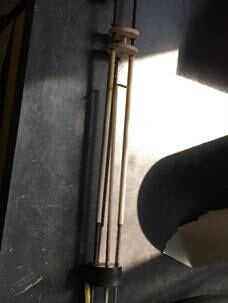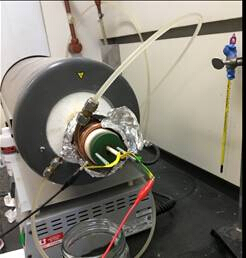Elektrochemische Impedanzspektroskopie
Überblick
Quelle: Kara Ingraham, Jared McCutchen, and Taylor D. Sparks, Department of Materials Science and Engineering, The University of Utah, Salt Lake City, UT
Elektrischer Widerstand ist die Fähigkeit eines elektrischen Schaltkreises Element, den Stromfluss zu widerstehen. Widerstand ist definiert durch Ohms Gesetz:
 (Gleichung 1)
(Gleichung 1)
Wo  ist die
ist die  Spannung und ist der Strom. Ohms Gesetz ist nützlich, um den Widerstand idealer Widerstände zu bestimmen. Viele Schaltungselemente sind jedoch komplexer und können nicht allein durch Widerstand beschrieben werden. Wenn z. B. ein Wechselstrom (AC) verwendet wird, hängt der Widerstand oft von der Frequenz des WECHSELsignals ab. Anstatt widerstanden allein zu verwenden, ist elektrische Impedanz ein genaueres und verallgemeinerbares Maß für die Fähigkeit eines Schaltkreises, dem Stromfluss zu widerstehen.
Spannung und ist der Strom. Ohms Gesetz ist nützlich, um den Widerstand idealer Widerstände zu bestimmen. Viele Schaltungselemente sind jedoch komplexer und können nicht allein durch Widerstand beschrieben werden. Wenn z. B. ein Wechselstrom (AC) verwendet wird, hängt der Widerstand oft von der Frequenz des WECHSELsignals ab. Anstatt widerstanden allein zu verwenden, ist elektrische Impedanz ein genaueres und verallgemeinerbares Maß für die Fähigkeit eines Schaltkreises, dem Stromfluss zu widerstehen.
Am häufigsten ist das Ziel der elektrischen Impedanzmessungen die Dekonvolution der gesamten elektrischen Impedanz einer Probe in Beiträge aus verschiedenen Mechanismen wie Widerstand, Kapazität oder Induktion.
Verfahren
- Besorgen Sie sich ein Testmodul und schließen Sie es über zwei Elektroden an die EIS-Instrumente an. Das Testmodul ( in Abbildung 3dargestellt ) enthält Daten, die zum Modellieren einer einfachen, bekannten Schaltung verwendet werden können. Es kann verwendet werden, um zu bestätigen, dass die Drähte richtig an die Maschine angeschlossen sind und dass alle Maschinenteile funktionieren.

Ergebnisse
Die Ergebnisse von EIS werden oft in einem Nyquist-Plot dargestellt, der reale Impedanz im Vergleich zu komplexer Impedanz bei jeder getesteten Frequenz zeigt. Die Handlung des durchgeführten Experiments ist in Abbildung 6zu sehen.

Abbildung 6: Screenshot des Computers nach Nyqu.
Anwendung und Zusammenfassung
Die elektrochemische Impedanzspektroskopie ist ein nützliches Werkzeug, um zu bestimmen, wie ein neues Material oder Gerät den Stromfluss behindert. Dies geschieht durch die Anwendung eines AC-Signals durch die Elektroden, die mit der Probe verbunden sind. Die Daten werden vom Computer in der komplexen Ebene gesammelt und geplottet. Mit Hilfe von Software kann der Graph nach bestimmten Teilen einer Schaltung modelliert werden. Diese Daten können oft sehr kompliziert sein und erfordern eine sorgfältige Analyse. Diese ...
Tags
pringen zu...
Videos aus dieser Sammlung:

Now Playing
Elektrochemische Impedanzspektroskopie
Materials Engineering
23.4K Ansichten

Optische Materialographie Teil 1: Probenvorbereitung
Materials Engineering
15.6K Ansichten

Optische Materialographie Teil 2: Bildanalyse
Materials Engineering
11.1K Ansichten

Röntgenphotoelektronenspektroskopie
Materials Engineering
21.9K Ansichten

Röntgenbeugung
Materials Engineering
89.6K Ansichten

Ionenfeinstrahlanlage (Focused Ion Beam)
Materials Engineering
9.0K Ansichten

Gerichtete Erstarrung und Phasenstabilisierung
Materials Engineering
6.7K Ansichten

Dynamische Differenzkalorimetrie
Materials Engineering
38.6K Ansichten

Temperaturleitfähigkeit und die Laser-Flash-Methode
Materials Engineering
13.4K Ansichten

Elektroplattieren von dünnen Schichten
Materials Engineering
20.2K Ansichten

Analyse der thermischen Ausdehnung mittels Dilatometrie
Materials Engineering
16.0K Ansichten

Keramische Faserverbundwerkstoffe und ihre Biegeeigenschaften
Materials Engineering
8.4K Ansichten

Nanokristalline Legierungen und Nanokorngrößenstabilität
Materials Engineering
5.2K Ansichten

Hydrogel-Synthese
Materials Engineering
23.8K Ansichten
Copyright © 2025 MyJoVE Corporation. Alle Rechte vorbehalten

